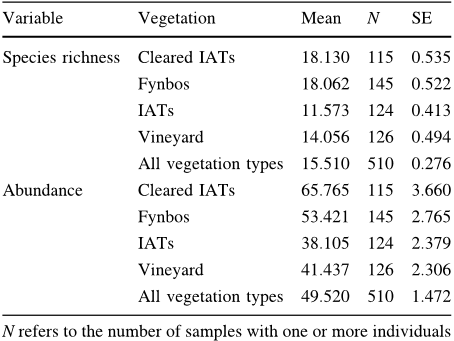




Did you find this useful? Give us your feedback












346 citations
...Their advantage is that they can be highly abundant and are sensitive to litter depth and type (Magoba and Samways 2012)....
[...]
...In South Africa, the spider Ozyptilia sp. is indicative of disturbance ecotones (Magoba and Samways 2012)....
[...]
...is indicative of disturbance ecotones (Magoba and Samways 2012)....
[...]
64 citations
38 citations
32 citations
28 citations
...For example, Magoba & Samways (2012) showed that adult dragonfly species richness was not hampered by riparian alien vegetation, but assemblages changed drastically in sites cleared of IAPs....
[...]
54 citations
51 citations
...2008), with the impacts of alien tree species in natural systems being dependent on invader attributes and on characteristics of the invaded community (Mason and French, 2008)....
[...]
...However, different ecosystems vary considerably in their susceptibility to invasion (Chytrý et al. 2008), with the impacts of alien tree species in natural systems being dependent on invader attributes and on characteristics of the invaded community (Mason and French, 2008)....
[...]
51 citations
...We also found the alien ant Linepithema humile to be common in fynbos, which may seem to contradict earlier findings where it is usually associated with disturbed areas (Suarez et al. 1998; Suarez et al. 2000; Holway et al. 2002; Carpintero et al. 2005; Ward 2005)....
[...]
49 citations
...…sp., the chrysomelid beetle Leptinotarsa sp., C. chloropyga, the reduviid hemipteran Ectrichodia crux, the nemopterdid neuropteran Laurhervasia setacea and the ant Componotus maculatus), as is the case with aquatic arthropods when IATs are removed from river banks (Magoba and Samways 2010)....
[...]
...the reduviid hemipteran Ectrichodia crux, the nemopterdid neuropteran Laurhervasia setacea and the ant Componotus maculatus), as is the case with aquatic arthropods when IATs are removed from river banks (Magoba and Samways 2010)....
[...]
46 citations
...The regional focus for this study is the CFR, a global biodiversity hotspot (Mittermeier et al. 2005) and a world centre of plant diversity and endemism (Linder 2005; Procheş and Cowling 2006), with 67% of plant species endemic to the region (Linder 2005)....
[...]
...Study sites Sampling was in three nature reserves and seven wine estates within the CFR (Table 1)....
[...]
...Invasive alien trees (IATs) are widespread in the Cape Floristic Region (CFR), South Africa, and their success attributed to their good colonizing abilities, especially in disturbed areas (Holmes and Richardson 1999)....
[...]
...Lowest species richness was in invaded areas, supporting other findings that invasion of fynbos by alien trees is highly impoverishing in the CFR (Ratsirarson et al. 2002; Pryke and Samways 2009)....
[...]
...IATs such as Pinus, Acacia and Eucalyptus species are of major commercial importance in South Africa, but they are also a threat to water supplies and biodiversity (Wittenberg and Cock 2001; Le Maitre et al. 2004), especially in the CFR (Macdonald and Richardson 1986)....
[...]